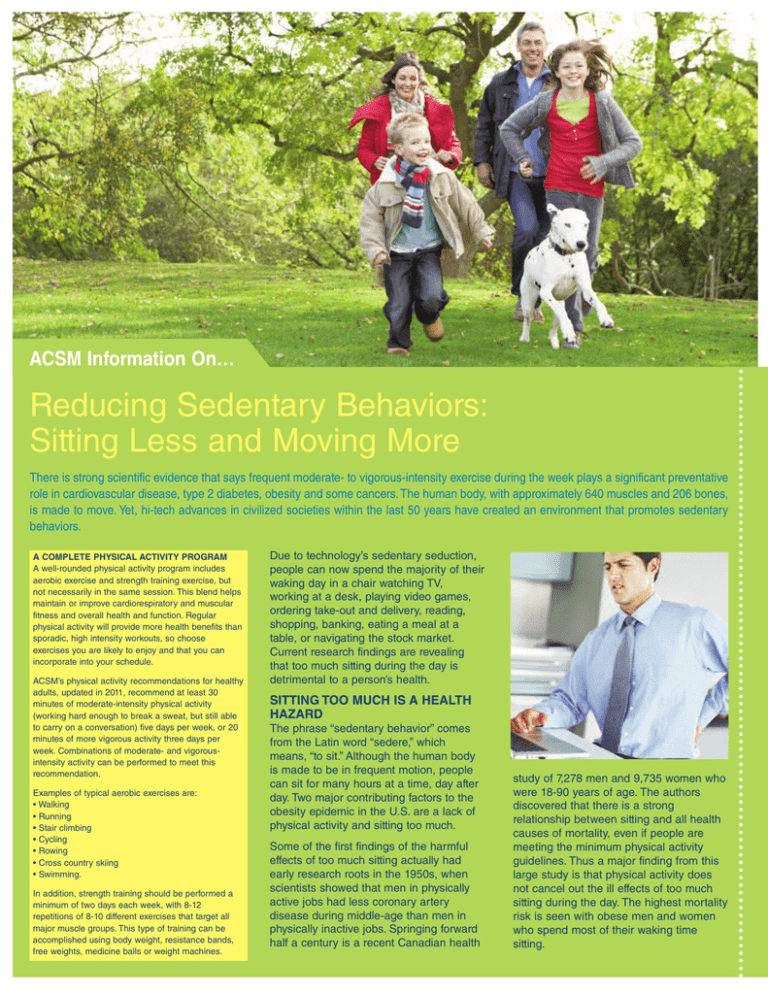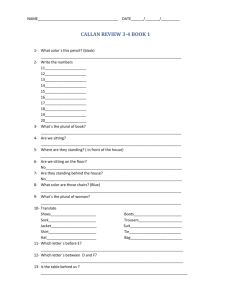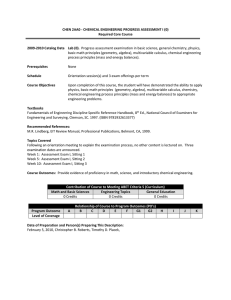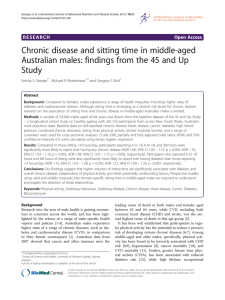Reducing Sedentary Behaviors: Sitting Less and Moving More ACSM Information On…
advertisement

ACSM Information On… Reducing Sedentary Behaviors: Sitting Less and Moving More There is strong scientific evidence that says frequent moderate- to vigorous-intensity exercise during the week plays a significant preventative role in cardiovascular disease, type 2 diabetes, obesity and some cancers. The human body, with approximately 640 muscles and 206 bones, is made to move. Yet, hi-tech advances in civilized societies within the last 50 years have created an environment that promotes sedentary behaviors. A COMPLETE PHYSICAL ACTIVITY PROGRAM A well-rounded physical activity program includes aerobic exercise and strength training exercise, but not necessarily in the same session. This blend helps maintain or improve cardiorespiratory and muscular fitness and overall health and function. Regular physical activity will provide more health benefits than sporadic, high intensity workouts, so choose exercises you are likely to enjoy and that you can incorporate into your schedule. ACSM’s physical activity recommendations for healthy adults, updated in 2011, recommend at least 30 minutes of moderate-intensity physical activity (working hard enough to break a sweat, but still able to carry on a conversation) five days per week, or 20 minutes of more vigorous activity three days per week. Combinations of moderate- and vigorousintensity activity can be performed to meet this recommendation. Examples of typical aerobic exercises are: • Walking • Running • Stair climbing • Cycling • Rowing • Cross country skiing • Swimming. In addition, strength training should be performed a minimum of two days each week, with 8-12 repetitions of 8-10 different exercises that target all major muscle groups. This type of training can be accomplished using body weight, resistance bands, free weights, medicine balls or weight machines. Due to technology’s sedentary seduction, people can now spend the majority of their waking day in a chair watching TV, working at a desk, playing video games, ordering take-out and delivery, reading, shopping, banking, eating a meal at a table, or navigating the stock market. Current research findings are revealing that too much sitting during the day is detrimental to a person’s health. SITTING TOO MUCH IS A HEALTH HAZARD The phrase “sedentary behavior” comes from the Latin word “sedere,” which means, “to sit.” Although the human body is made to be in frequent motion, people can sit for many hours at a time, day after day. Two major contributing factors to the obesity epidemic in the U.S. are a lack of physical activity and sitting too much. Some of the first findings of the harmful effects of too much sitting actually had early research roots in the 1950s, when scientists showed that men in physically active jobs had less coronary artery disease during middle-age than men in physically inactive jobs. Springing forward half a century is a recent Canadian health study of 7,278 men and 9,735 women who were 18-90 years of age. The authors discovered that there is a strong relationship between sitting and all health causes of mortality, even if people are meeting the minimum physical activity guidelines. Thus a major finding from this large study is that physical activity does not cancel out the ill effects of too much sitting during the day. The highest mortality risk is seen with obese men and women who spend most of their waking time sitting. WHY IS TOO MUCH SITTING SO HARMFUL? GET ACTIVE ACTION PLAN IDEAS FOR DAILY LIFE Fascinating new research is unraveling the mystery of why too much daily sitting is so unsafe. Scientists think that too much sitting impairs the body’s ability to deposit fat from the blood stream into the body. These constantly elevated blood fats are a risk factor for cardiovascular disease. In addition, researchers have observed that too much sitting during the day impairs the functioning of the body’s healthy cholesterol, known as HDL cholesterol. HDL is the scavenger cholesterol that cleans up plaque sticking to arteries. If healthy cholesterol loses its ability to clean arteries, it will also increase a person’s risk of cardiovascular disease. All studies are indicating that moving more during the day, in addition to getting the daily 30 minutes of moderate activity on a daily basis, is necessary to lower one’s risk of cardiovascular disease and other causes of mortality. 1. Take a family walk after dinner. 2. Get a pedometer and start tracking your steps. Progress up to 10,000 steps or more a day. 3. Walk your dog daily. 4. Replace those Sunday drives with Sunday walks. 5. When watching TV, stand up and move with every commercial break. 6. Walk up and down escalators instead of just riding them. 7. Run or walk fast when doing errands. 8. Pace the sidelines at your kids’ athletic games. 9. Walk up and down the shopping aisles at the store before you shop. 10. Pick up a new active hobby, such as cycling or hiking. 11. After reading six pages of a book, get up and move a little. 12. Try standing and moving whenever you are talking on a cellphone. 13. Play with your kids 15-30 minutes a day. 14. Dance to your favorite inspiring music selections. 15. Walk briskly in the mall. CREATE YOUR GET ACTIVE ACTION PLAN Creating a “get active action plan” incorporates different movements that fit seamlessly with your activities in work and your daily living. A very helpful and informative website for developing an action plan is http://www.letsmove.gov/ This website is full of innovative ideas and information about adding activity to one’s daily life. Here are some get active ideas to do at work and during your daily life. GET ACTIVE ACTION PLAN IDEAS FOR WORK 1. Take a walk break every time you take a coffee break. 2. Do some leisurely walking with colleagues after you eat lunch together at work. 3. Stand up and move whenever you have a drink of water at work. 4. Whenever possible stand up as opposed to sitting down. 5. Stand up and talk on business phone conversations. 6. Stop at the park on your way home from work and take a walk. 7. Walk to a co-worker's desk instead of emailing or calling her/him. 8. Walk briskly when headed to meetings. 9. Take the stairs whenever you can. 10. Take the long route to the restroom at work. THE KEY TO LIVING HEALTHIER IS STAYING ACTIVE Most people seek to live vibrant lives with optimal physical and cognitive functioning. However, there are considerable health consequences to living the life of a couch potato. It is important to dedicate 30 minutes of each day for your moderateintensity physical activity. In addition, making small movement changes in your daily life by creating your own “get active action plan” is equally important and to your overall health. Get moving, and stay moving! STAYING ACTIVE PAYS OFF! Those who are physically active tend to live longer, healthier lives. Research shows that moderate physical activity – such as 30 minutes a day of brisk walking – significantly contributes to longevity. Even a person with risk factors like high blood pressure, diabetes or even a smoking habit can gain real benefits from incorporating regular physical activity into their daily life. As many dieters have found, exercise can help you stay on a diet and lose weight. What’s more – regular exercise can help lower blood pressure, control blood sugar, improve cholesterol levels and build stronger, denser bones. THE FIRST STEP Before you begin an exercise program, take a fitness test, or substantially increase your level of activity, make sure to answer the following questions. This physical activity readiness questionnaire (PAR-Q) will help determine if you’re ready to begin an exercise routine or program. • Has your doctor ever said that you have a heart condition or that you should participate in physical activity only as recommended by a doctor? • Do you feel pain in your chest during physical activity? • In the past month, have you had chest pain when you were not doing physical activity? • Do you lose your balance from dizziness? Do you ever lose consciousness? • Do you have a bone or joint problem that could be made worse by a change in your physical activity? • Is your doctor currently prescribing drugs for your blood pressure or a heart condition? • Do you know of any reason you should not participate in physical activity? If you answered yes to one or more questions, if you are over 40 years of age and have recently been inactive, or if you are concerned about your health, consult a physician before taking a fitness test or substantially increasing your physical activity. If you answered no to each question, then it’s likely that you can safely begin exercising. PRIOR TO EXERCISE Prior to beginning any exercise program, including the activities depicted in this brochure, individuals should seek medical evaluation and clearance to engage in activity. Not all exercise programs are suitable for everyone, and some programs may result in injury. Activities should be carried out at a pace that is comfortable for the user. Users should discontinue participation in any exercise activity that causes pain or discomfort. In such event, medical consultation should be immediately obtained. ACSM grants permission to reproduce this brochure if it is reproduced in its entirety without alteration. The text may be reproduced in another publication if it is used in its entirety without alteration and the following statement is added: Reprinted with permission of the American College of Sports Medicine. Copyright © 2011 American College of Sports Medicine. This brochure was created by Len Kravitz, Ph.D. It is a product of ACSM’s Consumer Information Committee. Visit ACSM online at www.acsm.org.






